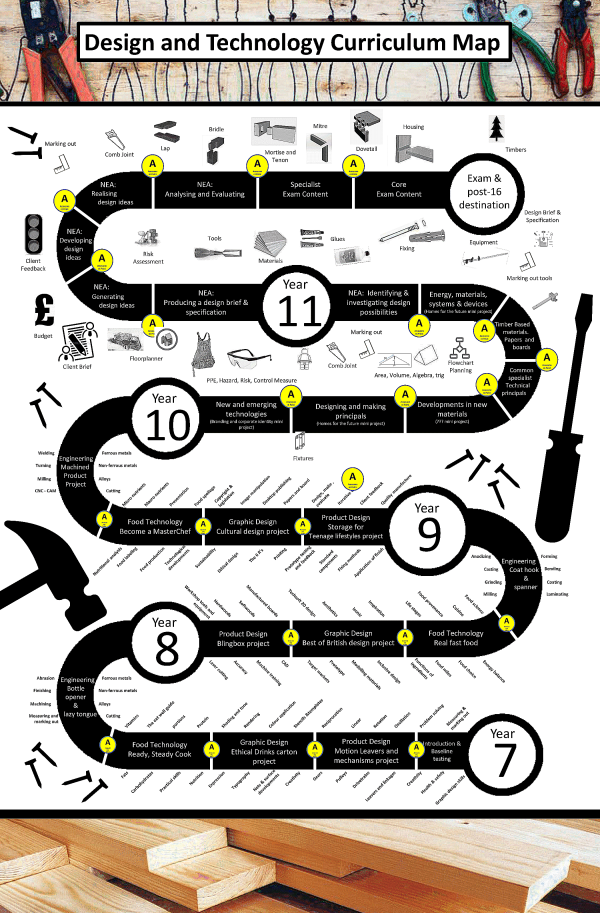Technology
Our Curriculum Intent
In Key Stage 3 at Clayton Hall Academy, students are taught Design and Technology in mixed ability classes for 3 hours per fortnight on a carousel system. Students rotate termly through Product Design, Engineering, Graphic Design and Food Technology. In each case they respond to a given brief and solve problems through researching, planning, designing, making and evaluating. A large portion of our Design and Technology Curriculum is focused on practical skills and we ensure that each student gets to take a project home at the end of each term. GCSE Design and Technology offers a broad and flexible approach to the subject. It is both a theoretical and a practical subject which requires the application of knowledge and an understanding of materials and material processing when developing ideas, producing products and evaluating them. Learners are encouraged in their design portfolio to use a wide range of design techniques including freehand drawings, isometric and orthographic drawing, as well as Computer Aided Design and Computer Aided Manufacture techniques.

Gold Standard Teaching and Learning in Design and Technology
Goal Orientated (Planning for Progress)
- Data driven Seating plans (highlighting DP, HAPs, MAPs, LAP, SEN)
- Students will engage in a Starter Task in every lesson (this can be a written or an oracy task).
- Differentiated Blooms, learning objectives displayed clearly.
- Students understand the Big Picture, what they are learning and why: links to prior learning made clear.
- Clearly identified links to Personal Development (RIC).
- Highly effective questioning to identify and address misconceptions.
- Formative and Summative Assessment to diagnose and inform next steps.
- Model excellence and how to achieve it.
- Revisit and ‘low stakes’ testing e.g.Starter and Plenary quizzes to make connections and support recall.
Open dialogue (Feedback for improvement)
- High quality feedback is given in response to specific pieces of work.
- Progress tracked on student’s assessment maps.
- Regular formative assessment will be varied and impactful e.g.framed as a question as opposed to a comment.
- Live marking is encouraged to manage workload and teachers are encouraged to have ‘purple pen in hand’ when they are intervening with students during the lesson.
- Literacy corrections in line with stickers.
- Student response to feedback (DIRT) using green pen.
- Self and peer-assessment used to develop independence.
Learning Environment
- Positive Learning Environment created by mutually respectful relationships (staff/pupil + pupil/pupil).
- Adults consistently model the values of the school and support curriculum intent.
- Engaged, enthused and independent learners- Lighting Fires Curriculum.
- Reward effort and resilience by providing opportunities for students to speculate, investigate, and make mistakes.
- Consistent application of the Consequence and Achievement system.
- Students show pride in their learning through the presentation of their work:
o Neat organised books/folders with Assessment maps and Target stickers
o Date and title underlined with a ruler- classwork and home study clearly identified
o Support should be provided for students who miss lessons, either through Teams or via email.
Differentiation for Challenge and support
- Use of data and student information to plan for individual needs. (Prior Attainment, FFT 20/5 Target data, SEND)
- Differentiated learning outcomes (these can be verbalised or displayed in the classroom)
- Stretch and challenge- upholding high expectations for HAPs (Over 50% of our cohort)
- Targeted questioning- include all students and make students think, using open and follow up questions to expand understanding. No hands up.
- Improve oracy in the classroom; students respond to questions or contributions in full sentences (talk for writing).
- Additional intervention for disadvantaged, Vulnerable, VIP, with a particular focus on Narrowing the Word Gap.
Key Stage 4 Examination Overview
Exam Board Details: AQA GCSE (9-1) Design and Technology
50% NEA Coursework
50% Exam
What resources could I buy or borrow that will help my child?
Practice exam papers PG Online
Students theory work from 9-11
What are the key websites or Apps that my child could use?
Technologystudent.co.uk
What can I do to encourage my child to take a further interest in Design and Technology?
Watch programmes such as Grand Designs
Subscribe to design museum/RSA
‘How it’s made’ magazine
What after school or other extracurricular activities are available in Design and Technology and when are they?
Make it club
Robotics club
Coursework support club
Email links
- Chris Quigley
- Graham South – Head of Technology
- Jo Shaw
- Kevin Oliver
- Les Mellor
- Mark Hopkins – 2nd in Technology
- Sophie Dutton-Johnson
To find out more about the curriculum we are studying please contact staff via email













